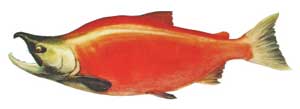Here are a few tips that you can do at home to help save our salmon.
"Washington must change the way it uses water. If we don't act, a lack of water will limit our economic potential as well as our ability to protect our natural resources."

|
|
 When washing your car, soapsuds, oil and antifreeze run off your driveway, into the storm drains and then the nearest stream, wetland or lake. Wash your car on the lawn to absorb the water. Or take your vehicle to a car wash that recycles water.
When washing your car, soapsuds, oil and antifreeze run off your driveway, into the storm drains and then the nearest stream, wetland or lake. Wash your car on the lawn to absorb the water. Or take your vehicle to a car wash that recycles water.
 Direct the downspout from your gutters away from pavement and into your yard where the rainwater can be absorbed.
Direct the downspout from your gutters away from pavement and into your yard where the rainwater can be absorbed.
 Own a septic system? Learn proper maintenance through a clickable guide on the Internet called "Septic Sense, Scents and Cents: Three Supreme Insights to the Fearless Flush." Visit the Washington Sea Grant Program home page at www.wsg.washington.edu.
Own a septic system? Learn proper maintenance through a clickable guide on the Internet called "Septic Sense, Scents and Cents: Three Supreme Insights to the Fearless Flush." Visit the Washington Sea Grant Program home page at www.wsg.washington.edu.
 Don't use septic tank cleaning compounds or additives. They can impair the tank's efficiency and damage the drainfield. Modern low flow toilets help reduce the volume of water that goes into septic tanks.
Don't use septic tank cleaning compounds or additives. They can impair the tank's efficiency and damage the drainfield. Modern low flow toilets help reduce the volume of water that goes into septic tanks.
 Most commercial household cleaners are toxic. Whether polishing the kitchen sink or scrubbing the toilet bowl, the water you rinse away likely contains chemicals poisonous to salmon. And that runoff eventually reaches a stream, lake or wetland-whether you have a septic tank or are connected to a sewer system.
Most commercial household cleaners are toxic. Whether polishing the kitchen sink or scrubbing the toilet bowl, the water you rinse away likely contains chemicals poisonous to salmon. And that runoff eventually reaches a stream, lake or wetland-whether you have a septic tank or are connected to a sewer system.
 Use low phosphate detergents for all household purposes. Phosphates fertilize the growth of undesirable algae in lakes and streams robbing oxygen from fish which then suffocate. Usually liquid detergents contain less phosphate than powders. Look for detergents labeled low phosphate at the grocery store.
Use low phosphate detergents for all household purposes. Phosphates fertilize the growth of undesirable algae in lakes and streams robbing oxygen from fish which then suffocate. Usually liquid detergents contain less phosphate than powders. Look for detergents labeled low phosphate at the grocery store.
 For a list of "green" cleaning products, and how to dispose of leftover toxic products, call the state Department of Ecology's Hazardous Substances Information Hotline at 1-800-633-7585.
For a list of "green" cleaning products, and how to dispose of leftover toxic products, call the state Department of Ecology's Hazardous Substances Information Hotline at 1-800-633-7585.
 The Washington Department of Health and local health departments are responsible for assuring safe, reliable drinking water. They oversee 16,000 public water systems serving nearly five million people. Learn more about your drinking water by reading your system's annual "consumer confidence" water quality report. If you get water from a private well, have it tested annually.
The Washington Department of Health and local health departments are responsible for assuring safe, reliable drinking water. They oversee 16,000 public water systems serving nearly five million people. Learn more about your drinking water by reading your system's annual "consumer confidence" water quality report. If you get water from a private well, have it tested annually.
 How do your daily activities affect salmon? Fill out the Department of Fish and Wildlife's "Your Impact on Salmon/Fish: A Self Assessment" at
www.wdfw.wa.gov/outreach/salmon/selfasmt/selfasmt.htm.
How do your daily activities affect salmon? Fill out the Department of Fish and Wildlife's "Your Impact on Salmon/Fish: A Self Assessment" at
www.wdfw.wa.gov/outreach/salmon/selfasmt/selfasmt.htm.
 Interested in conducting your own salmon restoration activities? Contact your local Regional Fisheries Enhancement Group or RFEG. The legislature created these groups to include citizens in salmon restoration efforts. These 14 non-profit volunteer groups cooperate with the Department of Fish and Wildlife to improve salmon resources throughout the state. For a listing of groups, visit www.wdfw.wa.gov//volunter/vol-3.htm.
Interested in conducting your own salmon restoration activities? Contact your local Regional Fisheries Enhancement Group or RFEG. The legislature created these groups to include citizens in salmon restoration efforts. These 14 non-profit volunteer groups cooperate with the Department of Fish and Wildlife to improve salmon resources throughout the state. For a listing of groups, visit www.wdfw.wa.gov//volunter/vol-3.htm.
 Find out about volunteer monitoring activities to help salmon at the Watch over Washington Web Site, www.wa.gov/ecology/wq/wow.
Find out about volunteer monitoring activities to help salmon at the Watch over Washington Web Site, www.wa.gov/ecology/wq/wow.
 Washington WaterWeeks offers water-related education and action events across the state. This year, WaterWeeks featured more than 130 events and activities, attracting thousands of participants. Visit www.waterweeks.org.
Washington WaterWeeks offers water-related education and action events across the state. This year, WaterWeeks featured more than 130 events and activities, attracting thousands of participants. Visit www.waterweeks.org. |
|

